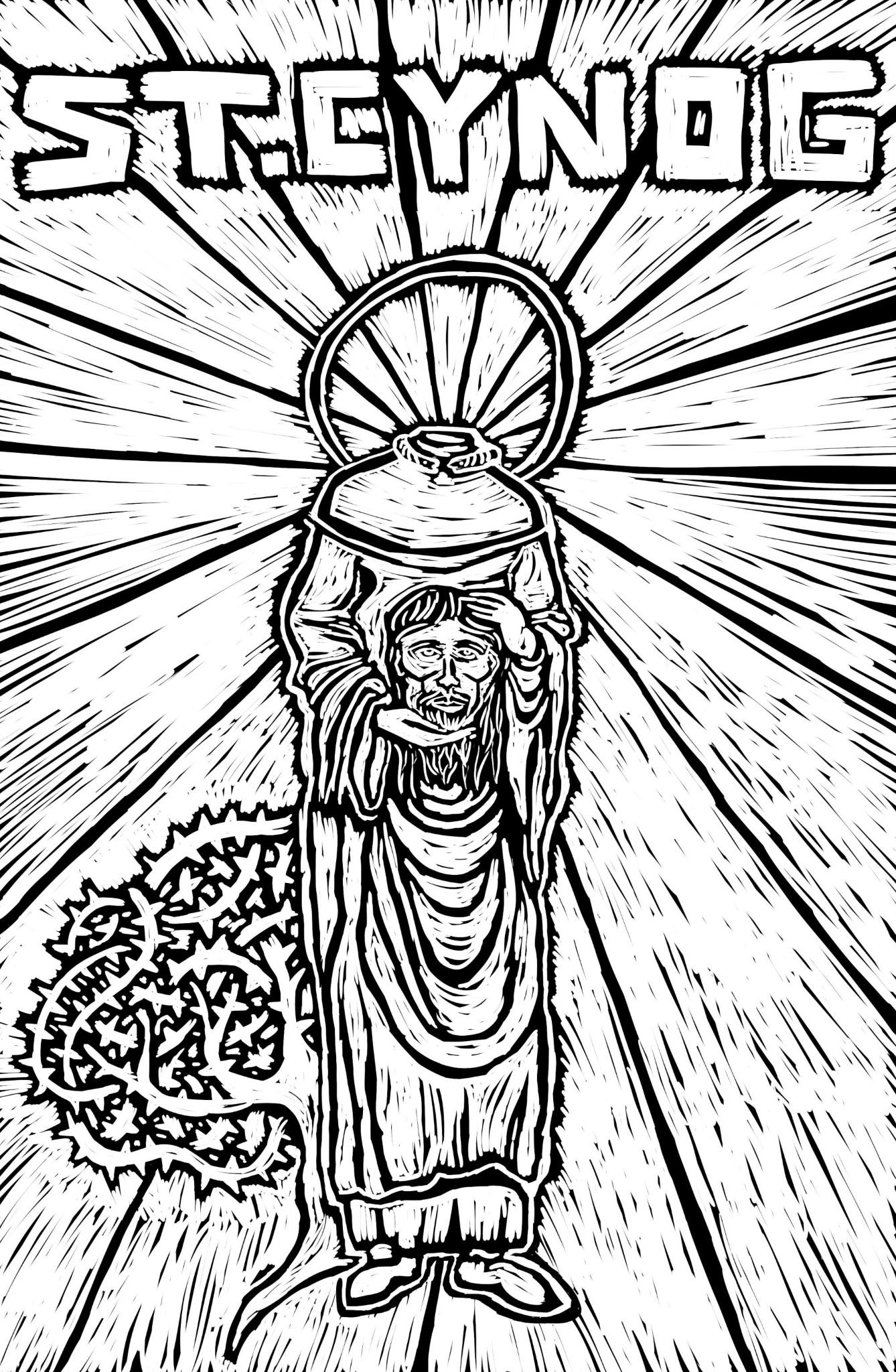Today1 marks the feast of St. Cynog, whose shrine is at Merthyr Cynog in Wales. Cynog (also spelled Cannauc or Kannauc) is a Welsh mythic saint, in the Tolkeinian Faery sense of myths as things that never happened but Always Are: a figure from the Celtic Dreamtime, where, to borrow shamelessly from Gordon White, a radical early Christianity melted into an indigenous cosmology of magic, elves, sunken cities, reincarnation and wandering rune masters like milk into coffee.
Cynog's story is one of sexual taboos, giants, magic rings, shamanic battles, and headlessness. A Welsh royal bastard of Irish blood who became a wandering mystic, Cynog traveled the countryside battling with giants and monsters with his father's golden torc which gave him exceptional strength and invincibility in combat. Eventually, Cynog took up a peaceful hermit's residence on the mountain Y Fan Oleu. One day, while hauling water, Cynog was set upon—by either pagan barbarians or jealous monks, depending on the version—who beheaded him. Cynog's body took up his head, carried it up the mountain, and laid it beneath a bramble bush, where a holy spring sprang from it.
Eight hundred years after his death, the magical torc of St. Cynog was still well-known in Wales and was described in detail by medieval scholars who claimed to have seen it. It was considered at one point to be the most precious treasure in Wales, but is today lost.
I discovered St. Cynog through Barry M. Lewis's Medieval Welsh Poems to Saints and Shrines. The poem to Cynog is by a medieval bard named Dafydd Epynt. The lines about Cynog's torc are the most compelling:
With a torc made by heaven's goldsmith,
[Its] Divine power was able to kill a devil
[...] A circle of sunlight able to cure
The skin of a hundred men of men of red cancer
Under blessed heaven there was never sent
Such a treasure to any man of Christendom.
It is the name of the Word in Greek,
A fair yellow O, like the one God.
But so too, are the lines about what Cynog can be called upon—beyond devil-killing and healing:
One who is lifeless from his pain
He causes to die or make a leap
No man has to endure three Thursdays2
With a debility.
Not only a figure of healing, then, but a figure of right dying (fitting for a battle saint). Death in the right time and the right way. Death as the embrace that relieves us from meaningless pain.
This is what makes Cynog wilder, even, than the other saints in Lewis's book (and there’s a lot of wild shit in these poems). He's a king, but in the sense of being an Irish rí (think Sanskrit rig)—a shining one. He's this physically regenerating psychopomp death shaman Crazy-Horse-meets-Taleissin type figure; a giant-killer while perhaps being the son of a giant himself (the torc Cynog wears on his neck was worn on his father's arm); also ancestrally tied to the biblical Mary, where Mary is clearly caught up with some deep faery queen lore. Cynog's headlessness is a motif reaching into the shamanism of the Neolithic, and Cynog's church stands on a holy site used since at least the Bronze Age. The Defynnog yew—sacred to ancient Celts & itself a being of sacred death—outside the church predates the 11th century building by as much as 4000 years. Oh, and the church font is inscribed with runes.
Prayer to St. Cynog
St. Cynog, sacred martyr, headless one. Steel parted your head from your body, and now your bones wear holy gold.
St. Cynog, Grandson of King Brychan, descendant of heaven’s Mary—upon your grave, the sick are made well, the blind given sight, and the dying are granted right death and rejoined to the earth. You bore your father’s torc, forged by heaven’s goldsmith, with the power to banish all devils. The king of the giants himself could not break your holy symbol upon his anvil. St. Cynog, mystic of the ancient people, giants ate your flesh, white wool grew over your wounds, your head was found beneath the bramble, and your body gave life to a holy spring.
St. Cynog, bless me with your circle of gold. Bless me with a good life and a good death in its due time. May the right words be spoken for me, may the right songs be sung for me. With your weapon, stand between me and the Devil, should he come. Holy saint, may the ancient yew guard your holy bones until the day of judgement. Unceasing, unending, ongoing, incoming, open, forever, forever, Amen. +
The description of Cynog's torc as a circle of sunlight stays with me. The idea of what is not lost, but Always Is.
Some sources say it’s October 9th, to be fair.
Thursday is interesting & specific here. At the very least, it’s a good day to say the prayer.







